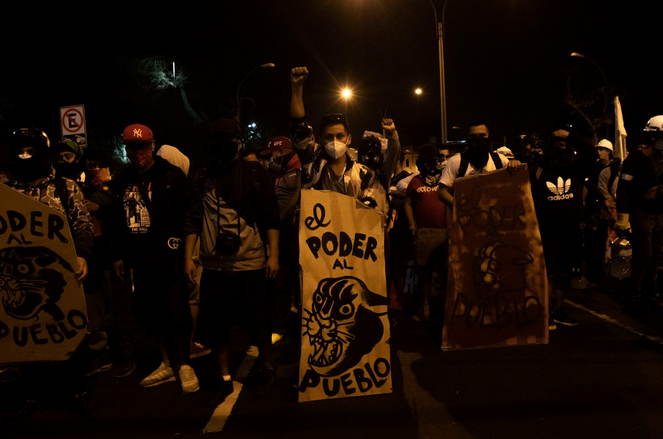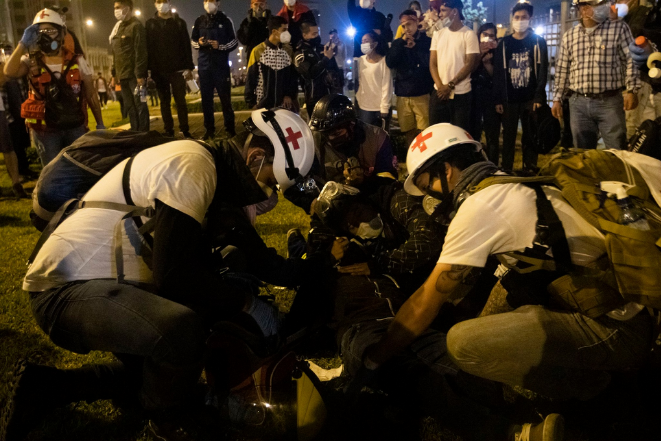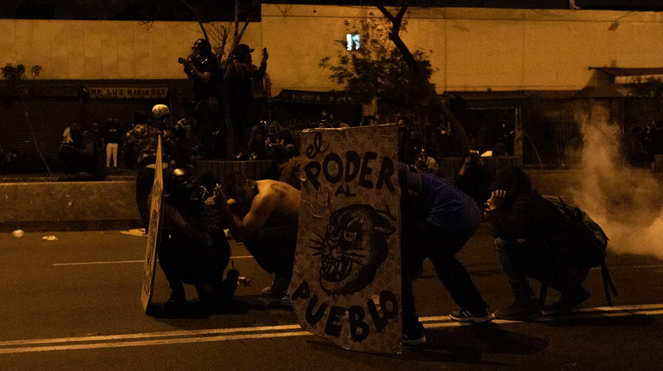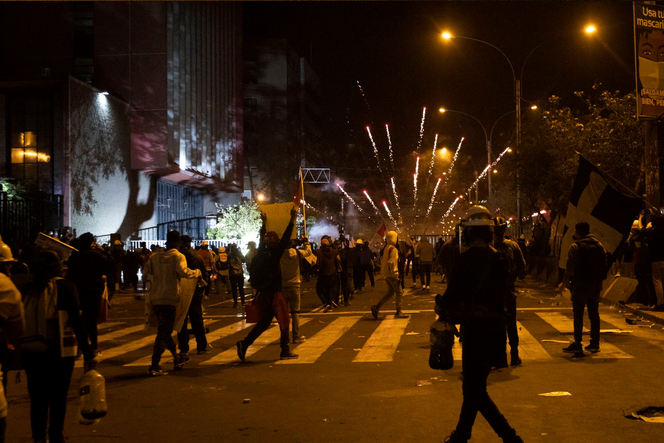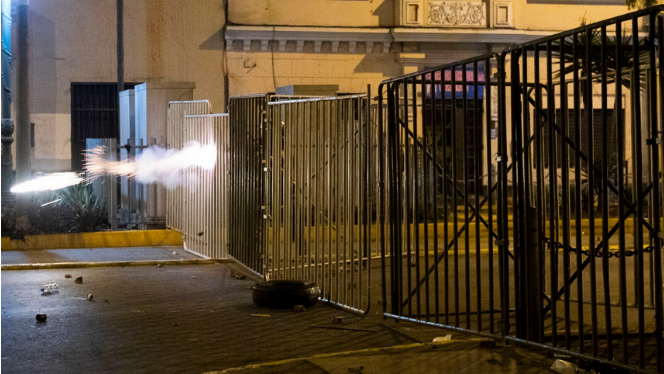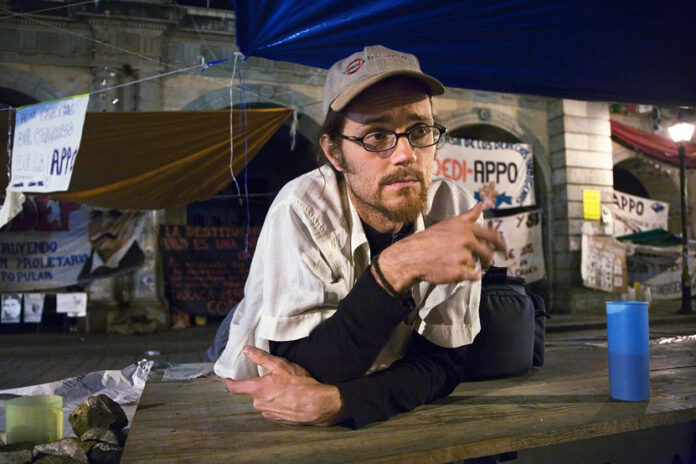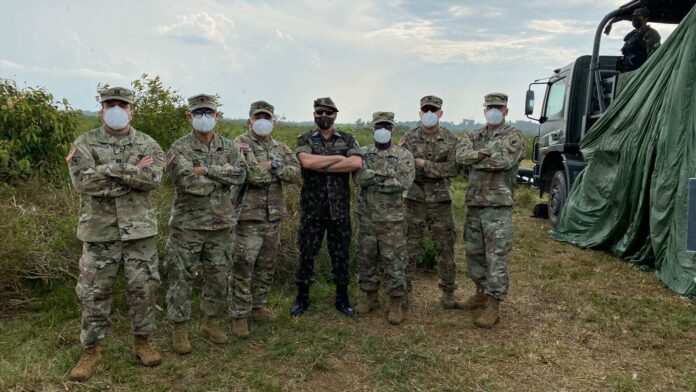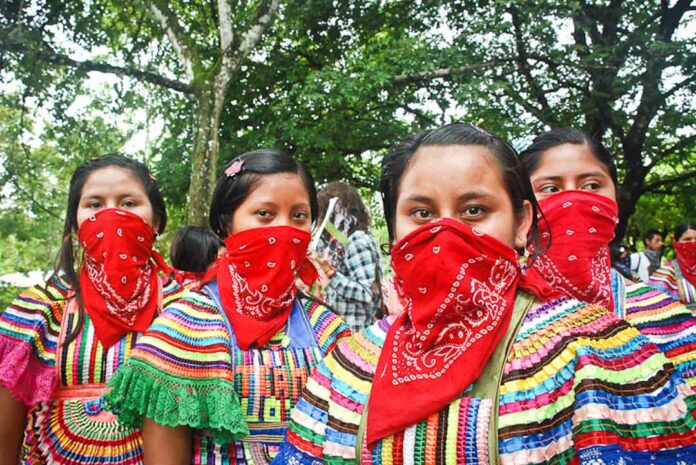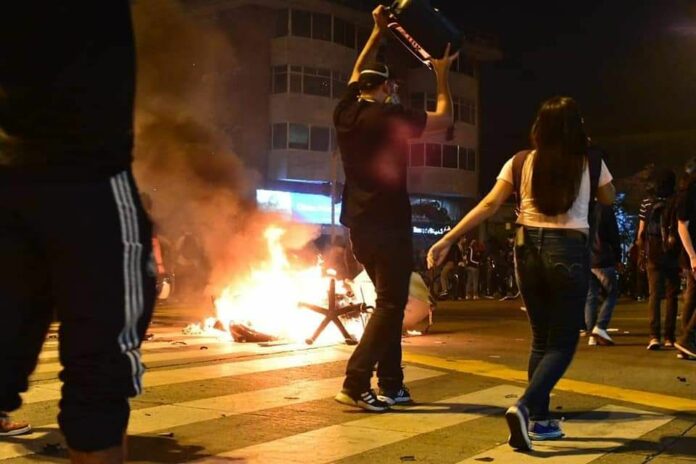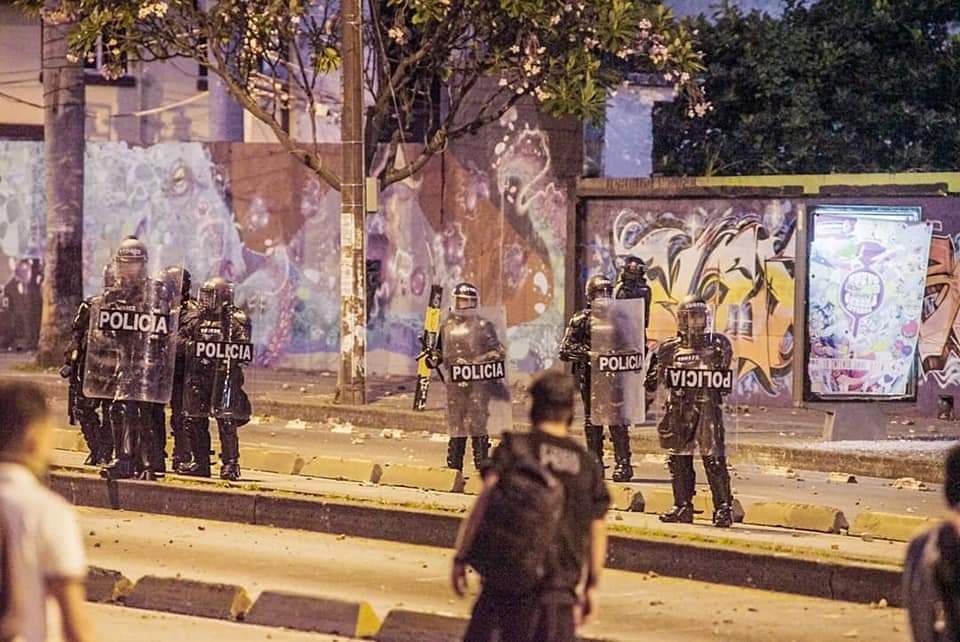The Zapatista Army of National Liberation (EZLN) has sought to mirror itself in various processes of struggle and resistance that are "below and to the left", as they say. For this reason they have decided to travel beyond Mexico, in the midst of the Covid-19 pandemic and against the backdrop of irregular or low-intensity warfare that is becoming more acute not only in Zapatista lands but across the Indigenous territories of Mexico and Latin America.
In a communiqué published on October 8, the Zapatistas emphasize that it is time for mutual listening and exploration with other resistances and rebellions. In the midst of the pandemic, which "demonstrated not only the vulnerabilities of human beings, but also the greed and stupidity of the national governments and their supposed opposition groups", they announce that they will travel to countries at the other end of the continent.
The communiqué highlights the Zapatistas’ intention “to find what makes us equal… not just our humanity that unites our different skin, our different ways of life, our different languages and colors. It is also, and above all, the common dream we have shared as a species as of the moment, in a seemingly distant Africa, from the lap of the very first woman, when we set out on the search for freedom that guided our first steps and which continues its path today”.
According to the statement, the first stop on this “planetary journey” will be the European continent, for which a Zapatista delegation will set sail from Mexican lands in April of 2021. After journeying through “various corners of Europe below and to the left", the EZLN members plan to arrive in Madrid, the Spanish capital, on August 13, 2021, “500 years after the supposed conquest of what is today Mexico. We will then immediately continue our journey”, the communiqué states.
The EZLN plans these actions 20 years after the so-called March of the Color of the Earth, a caravan in which the Zapatista comandantes and Subcomandante Marcos (today Galeano) traveled through the majority of Mexican states, together with the peoples who at that time made up the National Indigenous Congress. In this caravan they met and exchanged experiences with other peoples, organizations, collectives and individuals. “Now, 20 years later we will set sail and journey once again to tell the planet that in the world that we hold in our collective heart, there is room for everyone [todas, todos, todoas]. That is true for the simple reason that that world will only be possible if all of us struggle to build it”.
Below, the communiqué in its entirety:
Part Six: A Mountain on the High Seas
Communique from the Indigenous Revolutionary Clandestine Committee
General Command of the Zapatista Army for National Liberation
MÉXICO
October 5, 2020
To the National Indigenous Congress—Indigenous Governing Council:
To the Sixth in Mexico and abroad:
To the Networks of Resistance and Rebellion:
To all honest people who resist in every corner of the planet:
Sisters, brothers, hermanoas:
Compañeras, compañeros and compañeroas:
We Zapatista originary peoples of Mayan roots send you greetings and want to share with you our collective thought about what we have seen, heard, and felt.
First: We see and hear a socially sick world, fragmented into millions of people estranged from each other, doubled down in their efforts for individual survival but united under the oppression of a system that will do anything to satisfy its thirst for profit, even when its path is in direct contradiction to the existence of planet Earth.
This abomination of a system and its stupid defense of “progress” and “modernity” crashes into the wall of its own criminal reality: femicides. The murder of women has no color or nationality; it is global. If it is absurd and unreasonable for someone to be persecuted, disappeared, or murdered for the color of their skin, their race, their culture or their beliefs, it’s simply unbelievable that the fact of being a woman is equivalent to a death sentence or a life of marginalization.
The criminal logic of the murder of women is that of the system, escalating in predictable fashion (harassment, physical violence, mutilation, and murder) and backed by structural impunity (“she deserved it,” “she had tattoos,” “what was she doing out at that hour?” “dressed like that, what did she expect?”). This happens to women across geographies, social classes, races and ages from early girlhood to old age; gender is the one constant. The system is incapable of explaining how this reality goes hand in hand with its “development” and “progress.” The outrageous statistics say it all: the more “developed” a society is the higher the number of victims in this veritable war on women.
“Civilization” seems to be telling the originary peoples: “the proof of your underdevelopment is evident in your low rate of femicides. Here you go, here are your megaprojects, your trains, your thermoelectric plants, your mines, your dams, your shopping centers, your home electronics stores—television channel included. Learn to consume. Be like us. To pay back the debt of this “progressive” aid we’re offering, your lands, waters, cultures, and dignity won’t quite be enough—you’re going to have to throw in the lives of women.”
Second: We have seen and heard a nature which is gravely injured and yet, in its agony it is warning humanity that the worst is yet to come. Each “natural” disaster announces the next and conveniently forgets the cause: the actions of a human system.
Death and destruction are no longer off in the distance, limited by borders, customs and international agreements. Destruction in any corner of the world has repercussions on the whole planet.
Third: We see and hear the powerful retreating and taking cover within the so-called nation-states and their walls. In this impossible leap backward, they are reviving fascist nationalisms, ridiculous chauvinisms and a deafening torrent of meaningless blather. We are sounding the alarm about the coming wars fed by false, empty, deceptive histories that translate nationalities and races into supremacies that will be imposed with death and destruction. Disputes play out in various countries between the current overseers and those who aspire to succeed them, hiding the fact that the real boss, the owner, the ruler, is the same everywhere and has no nationality other than that of money. In the meantime, international organizations languish and become mere names, like museum artifacts… if that.
In the darkness and confusion that precede these wars we hear and see that any trace of creativity, intelligence and rationality is being attacked, persecuted and surrounded on all sides. Faced with critical thought, the powerful demand and impose their fanaticisms. They sow, cultivate, and harvest a death that is not only physical; it also includes the extinction of what is our unique human universality: intelligence, with all of its advances and achievements. New esoteric currents are created or reborn, secular and otherwise, disguised as intellectual fashions or pseudo-sciences. The arts and sciences are subordinated to political partisanship.
Fourth: The Covid-19 pandemic demonstrated not only the vulnerabilities of human beings, but also the greed and stupidity of the national governments and their supposed opposition groups. The most basic, commonsense measures were discarded on the gamble that the pandemic would play out in a short timeframe. As the epidemic’s timeline extended, numbers began to replace tragedies. Death became a statistic, lost amidst the noise of daily scandals and declarations in a dark contest of ridiculous nationalisms, playing with percentages like batting averages and earned runs to decide which team, or nation, is better or worse.
As we detailed in previous texts, Zapatismo opted for prevention and health safety measures based on the advice of scientists who offered their counsel without hesitation. The Zapatista communities want to show their appreciation for this assistance. Six months after the implementation of these measures (face masks or their equivalent, distance between people, cutting off direct personal contact with urban areas, 15-day quarantine for anyone who has been in contact with someone who is contagious, frequent handwashing with soap and water), we mourn the passing of three compañeros who presented two or more symptoms associated with Covid-19 and were directly exposed to infected persons.
Another eight compañeros and one compañera who died during this period presented one symptom associated with the illness. As we have no access to tests, we will assume that these 12 compañer@s died of corona virus (scientists told us to assume that any respiratory problem was Covid-19). These 12 deaths are our responsibility. They are not the fault of the 4T[i] or the opposition, of neoliberals or neoconservatives, of the sell-outs or the bourgies, or of conspiracies or plots. We think we should have implemented precautionary measures even more rigorously.
Currently, after the death of those 12 compañer@s, we are improving our prevention measures with the support of nongovernmental organizations and scientists who, individually or as a collective, are helping us orient our approach in order to be in a stronger position for any potential new outbreak. Tens of thousands of masks (affordable, reusable, specifically designed to avoid transmission by a probable contagious person to others, and adapted to our specific circumstances) have been distributed in all of the communities. Tens of thousands more are being produced in the insurgentes’ sewing and embroidery workshops as well as those in the communities. The measures we have recommended to our own communities as well as to our party-affiliated brothers and sisters—the widespread use of masks, a 2-week quarantine for those potentially infected, physical distance, continual hand and face washing with soap and water, and avoidance of the cities to the greatest extent possible—are all oriented toward containing any spread of contagion as well as permitting the maintenance of community life.
The details of what our strategy was and is will be analyzed at an appropriate time. For now we can say, with life pulsing through our bodies, that in our estimation (which may well be mistaken) it has been our approach of facing the threat as a community, not as an individual issue, and orienting our primary efforts toward prevention that has put us in a position to say now, as Zapatista peoples: here we are, resisting, living and struggling.
Now, all over the world, big capital intends to get people back on the streets to resume their role as consumers. What concerns capital are the problems of the market, the lethargic rate of commodity consumption.
We do need to get back on the streets, yes, but to struggle. As we’ve said before, life, and the struggle for life, is not an individual issue, but a collective one. Now we see that it’s not a national issue either, but a global one.
-*-
We have been seeing and hearing a lot of things along these lines, and we’ve given them a lot of thought. But not only that…
Fifth: We have also heard and seen the resistances and rebellions that, even when silenced or forgotten, do not cease to be vital indicators of a humanity that refuses to follow the system’s hurried pace toward collapse. The deadly train of progress advances with impeccable arrogance toward the edge of the cliff, with the conductor believing they are actually driving the train, forgetting they are just another employee of the system following the prison of the rails toward the abyss.
These are resistances and rebellions that remember those who have been taken from us as they struggle for—who would have thought—the most subversive cause out there in these worlds divided between neoliberals and neoconservatives: life. These resistances and rebellions understand—each according to their own way, time, and geography—that solutions cannot be found through faith in the various national governments, protected by borders and dressed in flags and different languages. These are resistances and rebellions that teach us Zapatistas that the solutions may be found below, in the basements and corners of the world, not in the halls of government or the offices of large corporations. They are resistances and rebellions that show us that if those above destroy bridges and seal borders, then we’ll just have to navigate rivers and oceans to find each other. They show us that the cure, if there is one, is global; it is the color of the earth, the color of the work that lives and dies in the streets and barrios, oceans and skies, hills and valleys—like the originary maize, it has many colors, hues, and sounds.
-*-
We saw and heard all of this and more. We saw and heard ourselves as what we are: a number that doesn’t count. Because life doesn’t count—it doesn’t sell, it doesn’t make the news, it doesn’t enter into the statistics, it doesn’t compete in the polls, it has no following on social media, it provokes no response, it does not represent political capital, party loyalty, or a trending scandal. Who cares if a small, a tiny group of originary peoples, indigenous peoples, lives, that is, struggles?
Because it turns out that we do live. Despite paramilitaries, pandemics, mega-projects, lies, slander, and oblivion, we live. And by that we mean, we struggle.
That is what we are thinking, that we will continue struggling, that is, continue living. We are thinking about the fraternal embrace of people in our own country and around the world that we have received throughout these years. We think that if life here resists and even, against all odds, flourishes, it is thanks to all those people who challenged distances, red tape, borders and differences of language and culture. We want to thank them: the men, women, and others—but above all the women—who confronted and defeated calendars and geographies to be with us.
In the mountains of Southeastern Mexico, all of the worlds in the world have found, and still find, a listener in our hearts. Their words and actions have fed our resistance and rebellion, which are just a continuation of the struggles of our predecessors.
People who walk the path of art and science found a way to embrace and encourage us, even from a distance. There were journalists, both bourgie and not, who reported the death and misery we suffered before and the dignity of life always. There have been people of all professions and trades who, through what were perhaps small gestures for them that meant a great deal to us, have been and continue to be at our sides.
These are the thoughts in our collective heart, and we also think that now is the time in which we Zapatistas [nosotras, nosotros, nosotroas] reciprocate the listening ear, word, and presence of those worlds, for those who are geographically near and far.
Sixth: We have decided that:
It is time for our hearts to dance again, and for their sounds and rhythm to not be those of mourning and resignation. Thus, various Zapatista delegations, men, women, and others, the color of our earth, will go out into the world, walking or setting sail to remote lands, oceans, and skies, not to seek out difference, superiority, or offense, much less pity or apology, but to find what makes us equal.
It is not just our humanity that unites our different skin, our different ways of life, our different languages and colors. It is also, and above all, the common dream we have shared as a species as of the moment, in a seemingly distant Africa, from the lap of the very first woman, when we set out on the search for freedom that guided our first steps and which continues its path today.
Our first destiny on this planetary journey will be the European continent.
We will leave Mexican lands and set sail for Europe in April of 2021. After journeying through various corners of Europe below and to the left, we plan to arrive in Madrid, the Spanish capital, on August 13, 2021, 500 years after the supposed conquest of what is today Mexico. We will then immediately continue our journey.
We want to speak to the Spanish people. Not to threaten them, scold them, insult them, or make demands of them, and not to demand they ask our forgiveness. We are not there to serve them nor demand they serve us. We want to tell the people of Spain two simple things:
One: You didn’t conquer us. We continue to resist and rebel.
Two: There’s no reason for you to ask our forgiveness for anything. Enough of this toying around with the distant past to justify, with demagoguery and hypocrisy, the current crimes in process: the murder of community organizers, like our brother Samir Flores Soberanes; the hidden genocides behind the megaprojects, conceived and carried out to please the most powerful player—capitalism—which wreaks punishment on all corners of the world; the pay-outs to and impunity for the paramilitaries; the buying off of peoples’ consciences and dignity with 30 pieces of silver.[ii]
We Zapatistas do NOT want to return to that past, not on our own, much less accompanied by someone trying to seed racial resentment and feed his outmoded nationalism with the supposed splendor of the Aztec Empire which built itself from the blood of its neighbors, and convince us in turn that with the fall of that empire, the originary peoples of these lands were defeated.
Neither the Spanish state nor the Catholic Church have to ask our forgiveness for anything. We will not echo those frauds who seek to legitimize themselves with our blood while they hide the fact that their hands are stained with it.
What is Spain going to ask our forgiveness for? For having birthed Cervantes? Or José Espronceda? León Felipe? Federico García Lorca? Manuel Vázquez Montalbán? Miguel Hernández? Pedro Salinas? Antonio Machado? Lope de Vega? Bécquer? Almudena Grandes? Panchito Varona, Ana Belén, Sabina, Serrat, Ibáñez, Llach, Amparanoia, Miguel Ríos, Paco de Lucía, Víctor Manuel, Aute siempre? Buñuel, Almodóvar and Agrado, Saura, Fernán Gómez, Fernando León, Bardem? Dalí, Miró, Goya, Picasso, el Greco and Velázquez? For some of the best critical thought in the world, born under the liberatory “A”? The Spanish Republic? The Spanish republican exile? Our Mayan brother Gonzalo Guerrero?
What is the Catholic Church going to ask our forgiveness for? For the life of Bartolomé de las Casas? For Don Samuel Ruiz García? For Arturo Lona? For Sergio Méndez Arceo? For Sister Chapis? For the lives of priests and religious and lay sisters who have walked beside the originary peoples without trying to lead or supplant them? For those who risk their freedom and their lives to defend human rights?
-*-
The year 2021 marks 20 years since the March of the Color of the Earth, the march we carried out alongside the peoples of the National Indigenous Congress to reclaim our place in this Nation that is now in total collapse.
Now, 20 years later we will set sail and journey once again to tell the planet that in the world that we hold in our collective heart, there is room for everyone [todas, todos, todoas]. That is true for the simple reason that that world will only be possible if all of us struggle to build it.
The Zapatista delegations will be constituted principally by women, not just because they want to reciprocate the embrace they received in earlier international gatherings, but also and above all to make clear to the Zapatista men that we are what we are and we aren’t what we aren’t thanks to them, for them, and with them.
We invite the CNI-CIG to form a delegation to accompany us and thus further enrich our word for the other who struggles in distant lands. We make a special invitation to the communities who hold up the name, image, and blood of our brother Samir Flores Soberanes, so that their pain, rage, struggle, and resistance travels far.
We invite those who hold the arts and sciences as their vocation, endeavor, and horizon to accompany our journey from a distance and help us spread the idea that in the sciences and the arts lie not only the possibility of the survival of humanity, but that of the birth of a new world.
In sum, we leave for Europe in April of 2021. Date and time? We don’t know… yet.
-*-
Compañeras, compañeros, compañeroas:
Brothers, sisters, and hermanoas:
This is our pledge:
In the face of the powerful trains, our canoes.
In the face of the thermoelectric plants, our little lights that the Zapatista women put in the care of the women who struggle all over the world.
In the face of walls and borders, our collective navigation.
In the face of big capital, a common cornfield.
In the face of the destruction of the planet, a mountain sailing through the small hours of the morning.
We are Zapatistas, carriers of the virus of resistance and rebellion. As such, we will go to the five continents.
That’s all…for now.
From the mountains of the Mexican Southeast
In the name of all of the Zapatista women, men, and others,
Subcomandante Insurgente Moisés
Mexico, October of 2020.
P.S. Yes, this is the sixth part and, like our journey, will go in inverse order. That is, the fifth part will come next, then the fourth, then the third, followed by the second, and finishing with the first.
[i] López Obrador deemed his own governing project the “Fourth Transformation” (4T), supposedly on par with historic events such as Mexican Independence (1810), a period of reform in the mid-19th century, and the Mexican Revolution (1910).
[ii] López Obrador has made repeated claims, starting in March 2019 and most recently in a September 20, 2020 press conference, that Spain and the Vatican should apologize for colonialism. The López Obrador administration has also doubled down on previous administrations’ socially and environmentally destructive capitalist mega-projects.



